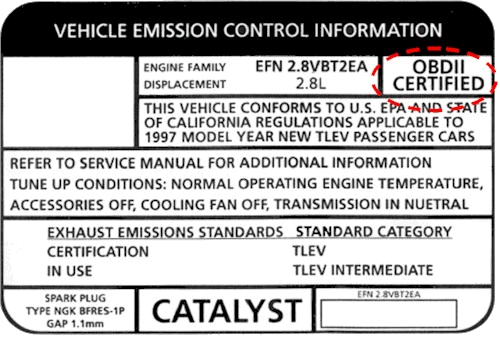Supported Vehicles
Will UltraGauge Blue work with my vehicle?
The following must be true:
1. "OBDII Certified" is printed on the vehicle's emission decal or in the vehicle's manual
2. Your vehicle is not listed on our compatibility exceptions list: Compatibility Exceptions
If you can not answer #1, please contact your vehicle's manufacturer.
USA Customers
All light trucks and passenger vehicles sold in the USA since 1996 are OBDII compliant. While OBD II compliance was federally mandated in the USA in 1996, some vehicle makes and models were compliant as early as 1994. Compliance is indicated on the vehicle's emissions decal located in the engine compartment. Below are examples of emission decals.
International Customers
Please confirm that your vehicle is OBDII certified. UltraGauge Blue is only compatible with vehicles which are OBDII certified. While OBDII compliance was mandated in the USA in 1996, this is not true internationally. Most countries eventually did adopt the OBDII standard. However, vehicles sold prior to OBDII adoption may or may not be OBDII compliant. For example, Australia did not adopt the OBDII until 2006. However, many pre-2006 vehicles are compliant, many are not. If you are uncertain, please contact your vehicle's manufacturer.
Diesel Vehicles: Ultragauge may not be able to accurately estimate fuel usage. Click here to learn more
UltraGauge Blue supports all OBDII protocols including:
| J1850 VPM | Early GM & Chrysler & very early Toyota |
| Ford | Early Ford |
| 9141 | Early Chrysler and Foreign |
| KWP 2000 | Rare, various |
| 11-bit CAN | Most 2008 and newer |
| 29-bit CAN | Most 2008 and newer Honda & Volvo |
| SW CAN | Used by GM to control accessory items such as radio, seats, door locks, etc. |
| MS CAN | Used by Ford to control accessory items such as radio, power seats, door locks, power windows, etc. |
Vehicles supported include any vehicle with an OBDII interface and includes: Passenger vehicles, SUVs, trucks, Class A, B & C RVs & Diesel vehicles
Installation is simple, simply plug UltraGauge into the vehicle's OBDII connector. The OBDII connector is typically located below the dash above the driver's foot controls. To determine the connector's location for your vehicle: OBDII locator
*Please see Compatibility Exceptions
To estimate which gauges may be available for your vehicle:
Vehicle Gauge Availability Estimator
Example OBDII Emission labels |
 |
 |
 |